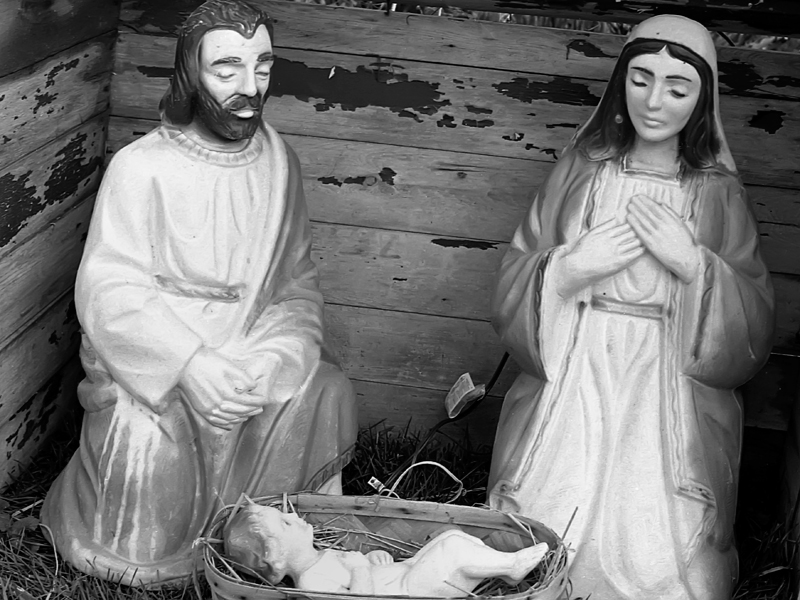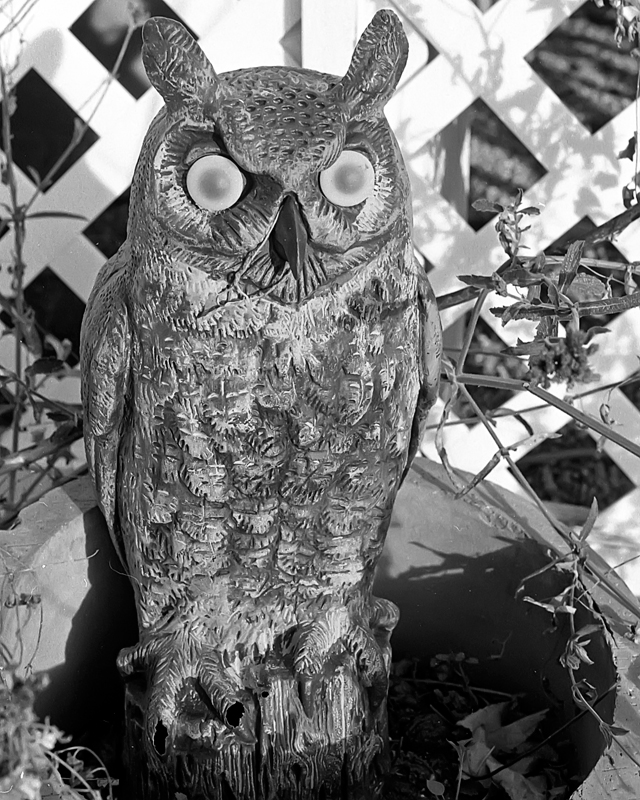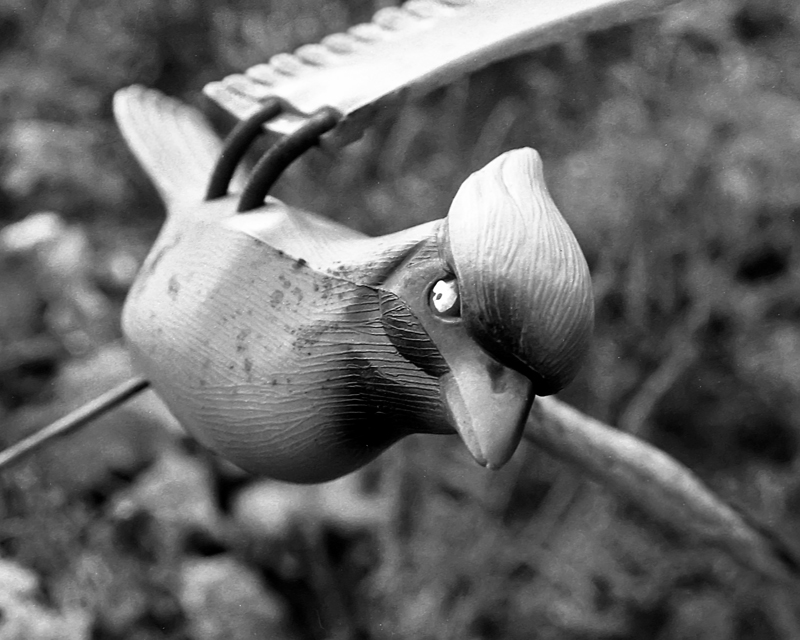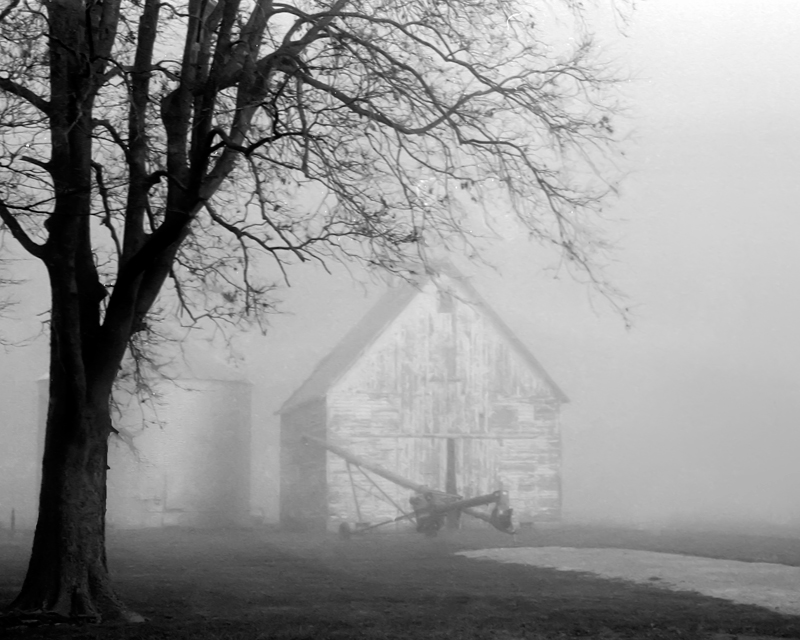Made: 1968 to 1974
Shutter: Electronically controlled Copal Square SE. Metal focal plane type.
Shutter Speeds: Step-less from 2 to 1/1000 and B.
Type: SLR
Film: 35mm
Exposure: Cds TTL stop down meter.
Standard Lens: Yashica Auto Yashinon-DS 50mm 1:1.7
Weight: 983 g
The Yashica TL Electro X was the first SLR that I bought back in 1974. I remember at the time it got some bad press because of its use of stop-down metering made it seem dated. Still for what it cost then, which I seem to remember I paid slightly less than $200, it is an excellent camera. Amazingly the camera in the picture is the actual camera that I bought all those years ago. I actually didn't didn't use it much as I bought a Canon F1 a few months later, however my brother used it for a few years. After that it went into storage and wasn't used until a couple years ago when I got into film again. I found it when I went looking for any film stuff that I still had. When I put a new battery in it the Yashica TL Electro X came back to life. And since then it has worked flawlessly. I should add that in the photo above I applied a filter for GAF 500 slide film. Maybe some old-timers may remember that film.
I should say something about batteries here. Some versions use 2.7 volts and others need 6 volts. Mine uses 6 volts and a l1325 works fine. If you get one of these and need to sort out battery issues a search on Google will turn up plenty of answers.
The Yashica TL Electro X was somewhat of a historic camera. It was the first camera to use electronic lights in its exposure meter. Instead of the match needle meter that was common at the time, the Electro X used two lighted under and over lighted arrows. The Yashica TL Electro X also had the first electronically controlled step-less shutter. So theoritically you can set the shutter speed to any speed between 2 seconds and 1/1000. Although of course you won't know exactly what speed you have set unless you are on one of the marked shutter speeds. The shutter will operate without a battery at one speed. It seems like I remember that speed was 1/1000. I do remember shooting some pictures with the assumption of that shutter speed before I got the new battery and they turned out fine.
The Yashica TL Electro X has a nice battery strength light. It also has mirror lock-up which isn't often found in an SLR of this price range. The lens mount is the of the M42 variety. So it can use a lot of the great screw mount lenses. And this is the camera that I use to test a lot of those lenses.
The Yashica TL Electro X seems to have most of the features that one could want. To me what makes it an excellent camera is the Yashica lenses. Their sharpness and good contrast make them very good for b&w work. The one here is the Yashinon-DS 50mm 1:1.7.
I like the patterns that shadows make in the winter. The Yashinon-DS 50mm 1:1.7 does well at capturing that. The film in both images is the much lamented, by me at least, now departed Legacy Pro 100.
The Yashica TL Electro X must have been a good seller. I have seen a lot of them on Ebay. It looks like you can easily find one for between $20 and $40. And in my opinion if you are looking for a capable M42 mount camera you can't do much better that the Yashica TL Electro X.
The last two pictures are with the Yashica Yashinon-DX 1:2.8 28mm lens.
On a foggy morning.
Our red barn on the same foggy morning.
Thursday, December 27, 2012
Monday, December 17, 2012
The Price of Photography in 1955
Occasionally I like to look at old photo equipment directories. They are a great source for the state of photography at given times. This one is from 1955.
Last night I was looking at the directory in the photo and I got to wondering how the price of photography would compare to what we experience today. According to the Dollar Times calculator one dollar from 1955 would be equal to $8.45 today.
One of the most basic needs for every photographer in 1955 would be for film.
*Includes processing.
I am wondering if there isn't something wrong with my cost comparison here, however this is the result of running some of the prices for mail order film through the inflation calculator. Like today you could save some money by buying bulk film. I saw one ad for a 100 feet of Tri-X for $3.98. That would come out to $33.63 in today's dollars. That's a deal I would jump at since Tri-X usually is more than $50 for a hundred feet these days. My best guess about film prices is that color film was probably much more expensive than color film is today. I can remember reading in a few places that one of the reasons the half-frame cameras became popular in the 1960's was that color film for 35mm had improved enough that a half-frame could produce a decent enlargement. Combine that with high prices for color film and a camera that could double your images had major appeal. As color film prices fell in the late 1960's so did the appeal of the half-frame camera.
So it would look like the photographer of the 1950's paid a lot more if he wanted color images than we do today. I imagine that is why I don't see many color pictures from that time.
The Argus C3 was still a popular economy camera in 1955. It's suggested price was $66.75. That would convert into $564 today. That's around what it would take to buy an entry level DSLR these days. Today it is easy to find a C3 for less than $20.
The Leica M-3 was about as top-of-the-line as you could get in 1955. It sold for $447 which translates into $3777 in 2012 dollars. That certainly is in the range that a top of the line camera would cost today. On Ebay I saw that a couple of camera and lens combinations like the one here sold for $1400 and $1475.
I think I will stop here with just a look at cameras and film from 1955. Its an interesting period to me since it is a couple of decades before I got seriously into photography. Probably it is the height of the all-mechanical camera manufactured in the West. By the time I came along most camera production had moved to Asia and electronics and plastic was starting to take hold.
Last night I was looking at the directory in the photo and I got to wondering how the price of photography would compare to what we experience today. According to the Dollar Times calculator one dollar from 1955 would be equal to $8.45 today.
One of the most basic needs for every photographer in 1955 would be for film.
| Film | 1955 | 2012 |
|---|---|---|
| Tri-X 20 exp | $2.50 | $21.54 |
| Kodachrome* 20 exp | $9.75 | $82.38 |
| Ektachrome 20 exp | $5.65 | $47.74 |
| Anscocolor* 20 exp | $1.98 | $16.73 |
I am wondering if there isn't something wrong with my cost comparison here, however this is the result of running some of the prices for mail order film through the inflation calculator. Like today you could save some money by buying bulk film. I saw one ad for a 100 feet of Tri-X for $3.98. That would come out to $33.63 in today's dollars. That's a deal I would jump at since Tri-X usually is more than $50 for a hundred feet these days. My best guess about film prices is that color film was probably much more expensive than color film is today. I can remember reading in a few places that one of the reasons the half-frame cameras became popular in the 1960's was that color film for 35mm had improved enough that a half-frame could produce a decent enlargement. Combine that with high prices for color film and a camera that could double your images had major appeal. As color film prices fell in the late 1960's so did the appeal of the half-frame camera.
So it would look like the photographer of the 1950's paid a lot more if he wanted color images than we do today. I imagine that is why I don't see many color pictures from that time.
The Argus C3 was still a popular economy camera in 1955. It's suggested price was $66.75. That would convert into $564 today. That's around what it would take to buy an entry level DSLR these days. Today it is easy to find a C3 for less than $20.
The Leica M-3 was about as top-of-the-line as you could get in 1955. It sold for $447 which translates into $3777 in 2012 dollars. That certainly is in the range that a top of the line camera would cost today. On Ebay I saw that a couple of camera and lens combinations like the one here sold for $1400 and $1475.
I think I will stop here with just a look at cameras and film from 1955. Its an interesting period to me since it is a couple of decades before I got seriously into photography. Probably it is the height of the all-mechanical camera manufactured in the West. By the time I came along most camera production had moved to Asia and electronics and plastic was starting to take hold.
Thursday, December 13, 2012
Minolta Maxxum 7000
I got this camera last June at a church sale, however I have only just now gotten around to making a gallery for it. The lens is a Minolta AF 50 F1.7.
The Minolta AF 50 F1.7 was in production from 1985 until 2006. It can still be used on Sony cameras. More details on this excellent lens are here.
Don't have much time for posting this week. Still I didn't want to skip a week entirely. So here is the Minolta Maxxum 7000 gallery.
The Minolta AF 50 F1.7 was in production from 1985 until 2006. It can still be used on Sony cameras. More details on this excellent lens are here.
Don't have much time for posting this week. Still I didn't want to skip a week entirely. So here is the Minolta Maxxum 7000 gallery.
Friday, December 7, 2012
Soligor 28-80mm F3.5-4.5 zoom macro
Couldn't find out much about this lens. I would guess it was made in the late 70's or early 80's since it is a zoom lens with an FD mount. Here is an image in Macro mode using Ilford HP5 developed in Xtol.
I have had this lens for about a year, but hadn't used it much. The main reason I got is because it was going for a cheap price on Ebay and is an FD lens with a useful zoom range. I figured it was worth a chance.
Lately, I decided to give it a test on the Canon T70. So far I have been pleased with the results. The Soligor is fairly compact for a zoom of its era and well-made. Another image with HP5.
I took this one with some of the last of the Kentmere 400 on a foggy morning.
Not much time for more commentary on this lens. There is a Soligor 28-80mm F3.5-4.5 zoom macro gallery here so you can form your own opinion.
Since FD lenses are not easily adaptable for use with digital cameras they haven't suffered the price inflation that some MF lens which can be adapted have. So excellent real Canon FD lens are still pretty reasonable. And third-party lenses like the Soligor are even cheaper. I know some people look down on such lenses, however I think that if you have a camera that uses the FD system then the FD Soligor 28-80mm F3.5-4.5 zoom macro might be worth trying. I also imagine this lens was available in most other mounts although I am not sure what kind of price those might bring.
I have had this lens for about a year, but hadn't used it much. The main reason I got is because it was going for a cheap price on Ebay and is an FD lens with a useful zoom range. I figured it was worth a chance.
Lately, I decided to give it a test on the Canon T70. So far I have been pleased with the results. The Soligor is fairly compact for a zoom of its era and well-made. Another image with HP5.
I took this one with some of the last of the Kentmere 400 on a foggy morning.
Not much time for more commentary on this lens. There is a Soligor 28-80mm F3.5-4.5 zoom macro gallery here so you can form your own opinion.
Since FD lenses are not easily adaptable for use with digital cameras they haven't suffered the price inflation that some MF lens which can be adapted have. So excellent real Canon FD lens are still pretty reasonable. And third-party lenses like the Soligor are even cheaper. I know some people look down on such lenses, however I think that if you have a camera that uses the FD system then the FD Soligor 28-80mm F3.5-4.5 zoom macro might be worth trying. I also imagine this lens was available in most other mounts although I am not sure what kind of price those might bring.
Tuesday, December 4, 2012
Zenit S
Produced: From 1955 to 1961.
Shutter: rubberized silk double cloth curtain, horizontal focal plane.
Shutter Speeds:
Before 1959: 1/25, 1/50, 1/100, 1/250, 1/500 +B
Since 1959: 1/30, 1/60, 1/125, 1/250, 1/500 +B
Lens: Industar-50 50mm f/3.5
The Zenit S is mostly a Zenit with flash synchronization added. That is what the S is for. The Zenit was one of the earliest SLRs being first produced in the USSR in 1952. The Zenit appears to have been developed by adding a reflex-box to a Zorgi 2. The Zenit S lacks features like a self-returning mirror that we have come to expect in an SLR, however this was typical of the early slrs. To me the most interesting feature of the Zenit S is its compactness. The Zenit S weighs only 538 grams. That compares well with the Olympus OM-1 at 510 grams, which caused a sensation when it was released nearly twenty years after the Zenit S.
The Zenit S that I have was made between 1959 and 1961 as indicated by the shutter speeds. The camera body is in excellent shape and functions well having been cleaned and serviced. The green leatherette took some getting used to, however I have come to like it. It really is striking how small this camera is for a classic era SLR. I still have the sense that I am handling one of my old rangefinders when I pick it up. In actual use things like the lack of a self-returning mirror make the Zenit S a little slower to use, however for me that is not a difficult thing to adjust to. The main thing I would change is to make the viewfinder brighter. Wide-open the viewfinder is usable, however it is fairly dim even in bright light. Also the Zenit S is one of those cameras where unless you are using it wide-open you have to manually change the aperture after focusing. Still I think that if you are able to slow down and adjust to the characteristics of the Zenit S then it is a very usable camera. Although likely it would be hard to get good results from the Zenit with any fast changing subject.
I was near the end of my bulk roll of Kentmere 400 when I loaded a roll to use in the Zenit S. And the roll turned out to be a short one. So I ended up getting only a few pictures. Still it looks like the Industar 50 in the Zenit S is capable.
Most of my other images with the Zenit S I put the lens on its hyper-focal setting.
So I am just staring with my experience of the Zenit S. I imagine that in time I will have more to report.
Shutter: rubberized silk double cloth curtain, horizontal focal plane.
Shutter Speeds:
Before 1959: 1/25, 1/50, 1/100, 1/250, 1/500 +B
Since 1959: 1/30, 1/60, 1/125, 1/250, 1/500 +B
Lens: Industar-50 50mm f/3.5
The Zenit S is mostly a Zenit with flash synchronization added. That is what the S is for. The Zenit was one of the earliest SLRs being first produced in the USSR in 1952. The Zenit appears to have been developed by adding a reflex-box to a Zorgi 2. The Zenit S lacks features like a self-returning mirror that we have come to expect in an SLR, however this was typical of the early slrs. To me the most interesting feature of the Zenit S is its compactness. The Zenit S weighs only 538 grams. That compares well with the Olympus OM-1 at 510 grams, which caused a sensation when it was released nearly twenty years after the Zenit S.
The Zenit S that I have was made between 1959 and 1961 as indicated by the shutter speeds. The camera body is in excellent shape and functions well having been cleaned and serviced. The green leatherette took some getting used to, however I have come to like it. It really is striking how small this camera is for a classic era SLR. I still have the sense that I am handling one of my old rangefinders when I pick it up. In actual use things like the lack of a self-returning mirror make the Zenit S a little slower to use, however for me that is not a difficult thing to adjust to. The main thing I would change is to make the viewfinder brighter. Wide-open the viewfinder is usable, however it is fairly dim even in bright light. Also the Zenit S is one of those cameras where unless you are using it wide-open you have to manually change the aperture after focusing. Still I think that if you are able to slow down and adjust to the characteristics of the Zenit S then it is a very usable camera. Although likely it would be hard to get good results from the Zenit with any fast changing subject.
I was near the end of my bulk roll of Kentmere 400 when I loaded a roll to use in the Zenit S. And the roll turned out to be a short one. So I ended up getting only a few pictures. Still it looks like the Industar 50 in the Zenit S is capable.
Most of my other images with the Zenit S I put the lens on its hyper-focal setting.
So I am just staring with my experience of the Zenit S. I imagine that in time I will have more to report.
Subscribe to:
Posts (Atom)















